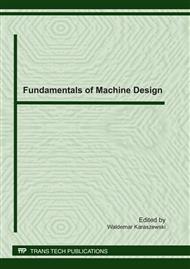p.83
p.90
p.97
p.106
p.119
p.128
p.135
p.143
p.156
Influence of Magnetorheological Fluid Volume onto Obtained Critical Pressures on Rotary Shaft Seals
Abstract:
Structure and basal application of magnetorheological fluids as well as their application in rotary shaft seals, have been presented in this study. As the application of magnetorheological fluid in seals is relatively purely known, the conducted studies were aimed at defining their operational parameters. The most essential was manner of the MR fluid delivery into oil gap, mostly the applied fluid volume. Not sufficient volume of the MR fluid often results in non-uniform oil gap filling what in turn decreases the seal efficiency. Results of studies on MR fluid-based seal burst pressure, conducted on specially designed testing stand, have been presented. The results comprise three oil gap sizes of d=0,15mm, d=0,3mm and d=0,5mm, for tests conducted with various volume of MR fluid applied on single sealing stage. Comparative values of the seal burst pressures obtained for three oil gap sizes of multi-stage seal, with the same apparent volume of MR fluid (the same fluid and oil gap volume ratio), were also presented.
Info:
Periodical:
Pages:
119-127
Citation:
Online since:
September 2011
Authors:
Price:
Сopyright:
© 2012 Trans Tech Publications Ltd. All Rights Reserved
Share:
Citation:


